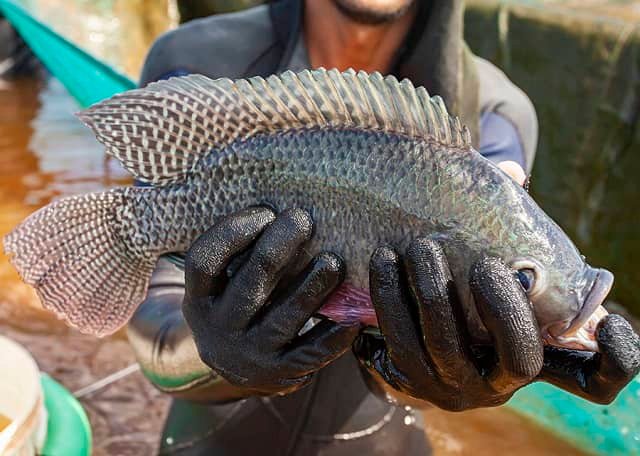
Fish, like all creatures, exhibit unique behavioral patterns and biological processes influenced by their environment. Temperature plays a critical role in their lives, affecting everything from metabolism to overall well-being.
For fish, water temperature is a crucial factor in their physiology, as deviations from their optimal temperature range can significantly impact their survival. Recent research conducted by scientists from the University of Murcia has delved into the daily thermal preference rhythms of Nile tilapia (Oreochromis niloticus) and how external factors, such as light and feeding schedules, can influence their choices.
Temperature Preferences
Fish, it turns out, have daily temperature preference rhythms. Just as humans seek cozier spots during the cold of the night and look for cooler spaces on a hot summer day, fish display daily rhythms in their thermal preferences. These rhythms have profound implications for their biological processes.
In the recent study, researchers aimed to understand how light and feeding schedules impact the daily thermal preference of Nile tilapia. They used a sophisticated multichamber tank with a thermal gradient to offer fish a variety of temperature options.
The Role of Lighting Conditions
In the first experiment, fish were exposed to different lighting conditions, including a standard Light:Dark (LD) cycle, an inverted LD cycle (DL), and constant darkness conditions (DD). What they found was intriguing: regardless of the feeding schedule (random, mid-light, mid-dark, or fasting), Nile tilapia exhibited a daily rhythm in their temperature preference. This suggests that LD cycles play a significant role in synchronizing their behaviors.
The tilapia chose higher temperatures as dusk approached and then shifted to lower temperatures as dawn broke. This transition was consistent in all phases of the experiment, highlighting the influence of external lighting conditions on fish behavior.
“Our results showed that Nile tilapia exhibited a marked daily rhythm of thermal preference in all light and feeding regimes investigated here. The role of light as the primary synchronizer was supported by the selection of higher temperatures at dusk and lower temperatures at dawn in all experimental phases of both independent experiments, regardless of feeding schedule,” report the researchers.
The Impact of Feeding Schedules
In the second experiment, researchers explored the impact of different feeding schedules on temperature preference. Fish were fed randomly (RD), in the mid-light phase (ML), in the mid-dark phase (MD), or not fed at all (fasting, FT).
Stay Always Informed
Join our communities to instantly receive the most important news, reports, and analysis from the aquaculture industry.
Fish fed in the MD phase chose cooler temperatures at night compared to those fed in the ML or RD phases, suggesting a link between feeding patterns and thermal preferences. Furthermore, fish that fasted selected temperatures below the thermal optimum, indicating that hunger can influence their thermal choices.
Stress-Induced Hyperthermia (SIH)
Interestingly, when fish were initially placed in the experimental tank with a thermal gradient, they exhibited a stress-induced hyperthermia (SIH) response, leading them to select higher temperatures. This response could be attributed to the unfamiliar environment and the stress it induced.
Implications for Welfare and Aquaculture
Understanding the daily thermal preference rhythms in fish has broader implications for the ecological and evolutionary aspects of fish thermoregulation. It provides valuable information for designing feeding protocols that can positively impact fish welfare.
By aligning feeding schedules with fish’s natural thermal preferences, we can optimize their well-being and, in turn, improve fish production.
Conclusion
“In the present study, both the light-dark cycle and feeding/FT regimes influenced the daily thermal preference rhythm in Nile tilapia. Light and dark cycles played a more powerful synchronizing role, although different feeding times and FT conditions impacted this rhythm, suggesting that thermal preference displays environmental plasticity in this fish species,” conclude the researchers.
In conclusion, this research unveils the intricate world of fish behavior and sheds light on how temperature, light, and feeding schedules intertwine to influence their daily lives. As we continue to unravel the secrets of fish thermoregulation, we gain the knowledge needed to promote the welfare of these aquatic creatures and improve our practices in aquaculture.
The research was funded by the “BLUESOLE” and “BBLUEAQUA” projects.
Contact
Gonzalo de Alba
Department of Physiology, Faculty of Biology
Regional Campus of International Excellence “Campus Mare Nostrum”
University of Murcia
30100 Murcia, Spain
Email: gonzalode.alba@um.es
Reference (open access)
Gonzalo de Alba, Francesca Conti, Jorge Sánchez, Laura Michelle Godoy, Francisco Javier Sánchez-Vázquez, José Fernando López-Olmeda, Luisa María Vera. Effect of light and feeding regimes on the daily rhythm of thermal preference in Nile tilapia (Oreochromis niloticus), Aquaculture, Volume 578, 2024, 740122,
ISSN 0044-8486, https://doi.org/10.1016/j.aquaculture.2023.740122.
Editor at the digital magazine AquaHoy. He holds a degree in Aquaculture Biology from the National University of Santa (UNS) and a Master’s degree in Science and Innovation Management from the Polytechnic University of Valencia, with postgraduate diplomas in Business Innovation and Innovation Management. He possesses extensive experience in the aquaculture and fisheries sector, having led the Fisheries Innovation Unit of the National Program for Innovation in Fisheries and Aquaculture (PNIPA). He has served as a senior consultant in technology watch, an innovation project formulator and advisor, and a lecturer at UNS. He is a member of the Peruvian College of Biologists and was recognized by the World Aquaculture Society (WAS) in 2016 for his contribution to aquaculture.




